Relevance: Sociology: FUNDAMENTALS OF SOCIOLOGY : 2. Sociology as Science: (b) Major theoretical strands of research methodology.
Major Theoretical Strands (Perspectives) of Sociology
FEMINIST PERSPECTIVE
Feminism is defined as the belief in the social, political, and economic equality of the sexes. The goal of feminism is to challenge the systemic inequalities women face on a daily basis. Feminism since its inception in the mid-1800s has branched into many movements, all of which identify themselves as ‘feminist,’ but vary in their philosophical perspectives.
Cultural Feminism
This theory believes that there is a distinctive ‘male culture’ and a ‘female culture,’ which are different largely due to the differing biology of men and women, and they manifest in differing social behaviors. So for e.g. cultural feminists see nurturing and caring to be more of ‘female culture,’ than ‘male culture,’ and this they recognize as being intrinsic to the process of being female. Cultural feminists also believe that the contributions of ‘female culture,’ such as child care, domestic work etc. have been disregarded and greatly devalued in society, largely because they are unpaid. They also believe that social systems have evolved along lines of ‘male culture,’ and include traits like competition and aggression, and so they tend to isolate women. The focus of cultural feminists is to have ‘women’s work’ – particularly in the domestic care and child care arena recognized as economically and socially productive. And to change the work place environment outside the domestic realm to incorporate more ‘female culture’ and make it accessible to women.
Liberal Feminism
Liberal Feminism has a perspective that is diametrically opposite to that of cultural feminism. They believe that the differences in male and female social behavior are not so much because of biology but because of how their environment conditions them to be. They believe that gender identity and behavior are cultural constructs, products of the discrepancies in the legal and social opportunities available to men and women, and of the differences in how gender norms for behavior, choices, expectations, etc are set by society for girls and boys, and men and women. The focus of liberal feminists therefore is on creating a completely level playing field for the genders in terms of legal and social systems, and gender norms and gender socializations for that is what they believe is the key to the gender equality.
Socialist (Marxist) Feminism
This theory recognizes that in addition to gender discrimination, there are many other social venues for discrimination, such as race, class, education, sexual orientation and economics. And they believe that each category of discrimination compounds a woman’s experience of gender discrimination. So for example a poor, uneducated black American woman would be three times more disadvantaged than a wealthy, educated white American woman. So the Socialist Feminist perspective is that for there to be total gender equity all forms of discrimination in society will have to be simultaneously addressed.
Radical Feminism
It believes that a dominating patriarchy is the primary form of female oppression in society, regardless of class, color and economics. The control that men have had over women is largely through brute, physical force. The focus of Radical Feminists is largely on the violence that women suffer, and their social subjugation through violent behavior inflicted by men. And they believe that this is what keeps women oppressed whether they are rich or poor, black or white, educated or illiterate. The focus of Radical feminism is therefore on fighting gender related violence.
Womanism (Woman of Color Feminism)
This is the feminist movement of the women of color. It started in the U.S. and includes black, Hispanic and Asian-American women. Womanists believe that is it not men who are their primary oppressors but a white, racist society. And that men of color suffer from this racial and related class discrimination, just as much as they do as women. They do recognize the oppression of colored women by colored men, but they believe that this is a result of the indignity the colored man suffers. So the focus of the Womanist movement has been on joining hands with their colored brothers to fight for racial equality.
Anarcha-Feminism (Anarchist Feminism)
This theory believes that the domination of the patriarchy is the inadvertent result of a larger societal thinking that fosters a hierarchical set-up of society. So the focus of Anarcha-feminists is the fight against the state and the dismantling of a hierarchical governance, for that they believe is the only road to equality of genders and all other social stratas.
EcoFeminism
Ecofeminists believe that it is the patriarchal system that causes the oppression of both women and the environment. This involves ‘ownership,’ ruthless destruction and exploitation for men’s own profit and pleasure. Ecofeminists argue that men in power are able to take advantage of both women and the environment because they see them passive and helpless. Some ecofeminists also argue that besides a common history of exploitation by men, women and the environment also share a deep connectivity because of their common capacity to produce, nurture and sustain. So ecofeminists believe that to end gender injustice, it is important to protect and honor the earth and its environment.
Post-Colonial Feminism (Third World Feminism)
This form of feminism emerged in third world countries that had earlier been colonized by European countries. These feminists are of the opinion that the racial and economic oppression their countries were subjected to as colonies is what marginalized women in the postcolonial societies. They generally reject Radical and Liberal Feminism, and do not accept the notion that the traditional patriarchy in their respective countries are the main cause for women’s oppression. Postcolonial feminists have objected to western standards of modernization and empowerment of women in their countries and believe that they have to work for gender equality within the logic of their own cultural models.
Post-Modern Feminism (French Feminism)
The fundamental argument of this branch of feminism is that there is not one unique, absolute definition for gender – neither biologically nor socially but that gender is a variant constructed through language. They believe that a dualistic vision of gender creates a constrictive dichotomy which in itself becomes restrictive of women. Post-modern feminist Judith Butler argues “woman” is a questionable category, because it involves much more – class, race, sexuality, and other aspects of individualism – all of which in some ways define each woman independently. She states that therefore “gender” is a “performative” word. Thus the contention of postmodern feminists is that there is no single basis for women’s subordination and no single method of dealing with the issues.
Facts never interpret themselves. To make sense out of life, we use our common sense. That is, to understand our experiences (our “facts”), we place them into a framework of more-or-less related ideas. Sociologists do this, too, but they place their observations into a conceptual framework called a theory. A theory is a general statement about how some parts of the world fit together and how they work. It is an explanation of how two or more “facts” are related to one another.
Functionalism

- The central idea of functional analysis is that society is a whole unit, made up of interrelated parts that work together. Functional analysis (also known as functionalism and structural functionalism) is rooted in the origins of sociology. Auguste Comte and Herbert Spencer viewed society as a kind of living organism. Just as a person or animal has organs that function together, they wrote, so does society. And like an organism, if society is to function smoothly, its parts must work together in harmony.
- Emile Durkheim also viewed society as being composed of many parts, each with its own function. When all the parts of society fulfill their functions, society is in a “normal” state. If they do not fulfill their functions, society is in an “abnormal” or “pathological” state. To understand society, then, functionalists say that we need to look at both structure (how the parts of a society fit together to make the whole) and function (what each part does, how it contributes to society).
- Robert Merton and Functionalism. Robert Merton (1910–2003) dismissed the organic analogy, but he did maintain the essence of functionalism—the image of society as a whole composed of parts that work together. Merton used the term functions to refer to the beneficial consequences of people’s actions: Functions help keep a group (society, social system) in balance. In contrast, dysfunctions are consequences that harm a society: They undermine a system’s equilibrium.
- Functions can be either manifest or latent. If an action is intended to help some part of a system, it is a manifest function. For example, suppose that government officials become concerned about our low rate of childbirth. Congress offers a $10,000 bonus for every child born to a married couple. The intention, or manifest function, of the bonus is to increase childbearing within the family unit. Merton pointed out that people’s actions can also have latent functions; that is, they can have unintended consequences that help a system adjust. Let’s suppose that the bonus works. As the birth rate jumps, so does the sale of diapers and baby furniture. Because the benefits to these businesses were not the intended consequences, they are latent functions of the bonus.
- Of course, human actions can also hurt a system. Because such consequences usually are unintended, Merton called them latent dysfunctions. Let’s assume that the government has failed to specify a “stopping point” with regard to its bonus system. To collect more bonuses, some people keep on having children. The more children they have, however, the more they need the next bonus to survive. Large families become common, and poverty increases. Welfare is reinstated, taxes jump, and the nation erupts in protest. Because these results were not intended and because they harmed the social system, they would be latent dysfunctions of the bonus program.
- In Sum : From the perspective of functional analysis, society is a functioning unit, with each part related to the whole. Whenever we examine a smaller part, we need to look for its functions and dysfunctions to see how it is related to the larger unit. This basic approach can be applied to any social group, whether an entire society, a college, or even a group as small as a family.

Criticisms of Functionalism
- The conflict theorists regard the functionalist approach as Utopian in nature and emphasize the need to study conflict in systems of stratification as a universal, all pervasive and an omnipresent phenomena.
- The conflict theorists say that all societies are characterized by some degree of constraint, disagreement, uncertainty, control dysfunctional and coercions that can’t be ignored.
- However, unlike the functionalists, the conflict theorists do say that, conflict leads to stability and consensus in society.
- It becomes important to study also the nature of consensus and equilibrium in a given system with conflict.
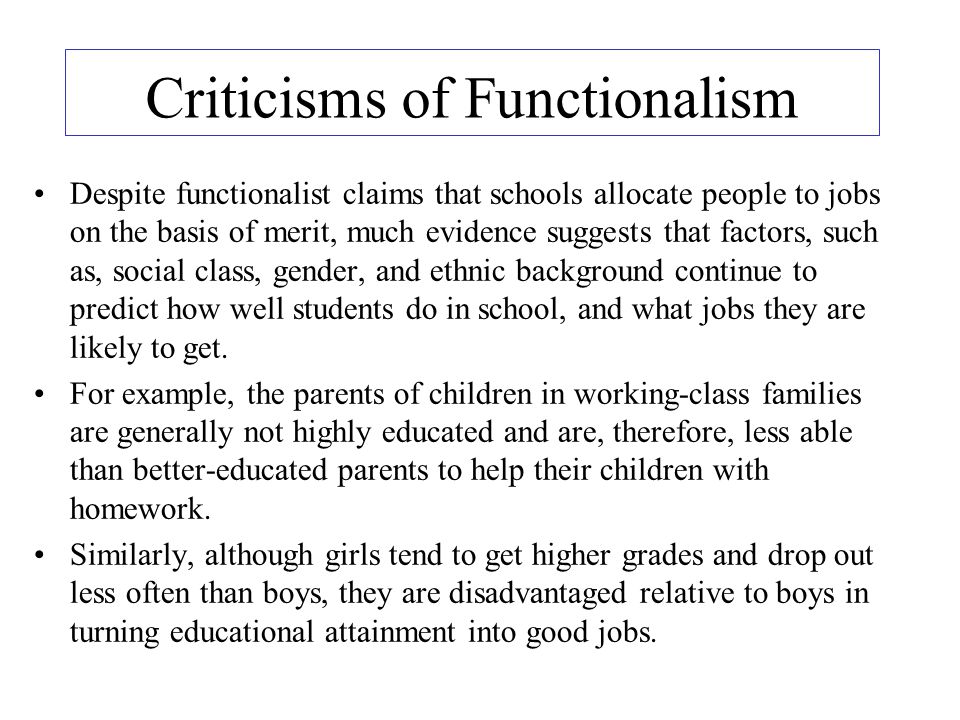
Marxism (Conflict Perspectives)

- The conflict perspective views society as composed of diverse groups with conflicting values and interests. In any society, these groups have differential access to wealth, power, and prestige. The most important aspects of the conflict perspective are the Marxian approach, which focuses on economic determinism and the importance of social class, and the neoconflict approach, which focuses on differential power and
- The Marxian Approach to Conflict: The theoretical roots of the conflict perspective can be traced to Karl Marx. Often, the values and interests of different groups conflict with one another. According to Marx, these conflicts are determined by economics and are based on social class, and the struggle between the different values and interests of the bourgeoisie and the proletariat is inevitable. When these battles occur, the dominant group attempts to force its values and ideology on less powerful groups. The result is the domination and exploitation of the masses (the proletariat) by the rich and powerful members of society (the bourgeoisie). The conflict perspective is not solely Marxist sociology, however; today conflict theorists often take a neoconflict approach.
- The Neoconflict Approach: Social conflict can be viewed as a necessary and even functional social process. From this perspective, conflict necessitates negotiation and compromise; hence it can produce order and a reaffirmation of the social structure. In a diverse nation like the United States, conflict between racial, ethnic, religious, age, gender, and political groups is inevitable but not necessarily destructive. For example, attempts to balance the national budget have typically been thwarted by bickering over what areas of the budget should be increased and which should be cut.
- Those dependent on Medicare and Social Security resist cuts to those programs and would rather see cuts in, for example, the defence budget or federal aid to tobacco growers. Meanwhile, Pentagon officials and cigarette manufacturers are not about to sit back and allow legislators to balance the budget at their expense. Both sides employ powerful lobbyists to persuade legislators to vote for their relative interests. These political and ideological quarrels are marked by compromises or tradeoffs that may not satisfy either group but also do not allow one interest to totally dominate the other. When society is confronted by an external threat, these internal conflicts may decrease, for, as is often said, nothing unites a group like a common enemy. From this perspective, conflict is dysfunctional only if it threatens one or more of society’s core values.
- Neo-conflict theorists also contend that class conflict in industrialized countries is not so much a struggle over the means of production (as Marx argued) but rather a result of the unequal distribution of authority For example, the differing power and prestige of college professors and students sometimes lead to tension and conflict between the two groups that has nothing to do with the ownership of property or the means of production. This version of the conflict perspective focuses on differences in power and authority and the exploitation of some groups by other, more powerful groups. A good example of this approach can be seen in the work of C.Wright Mills.
- Wright Mills and the “Power Elite” C.Wright Mills promoted the conflict perspective for analyzing the distribution of power and authority in the United States. In The Power Elite (1956), he contended that post–World War II U.S. society was dominated by a powerful military, industrial, and political elite that shaped foreign and domestic policy for the benefit of the wealthy and powerful class. His approach focused on historical and structural analyses of class conflict and the uses of ideology for domination.
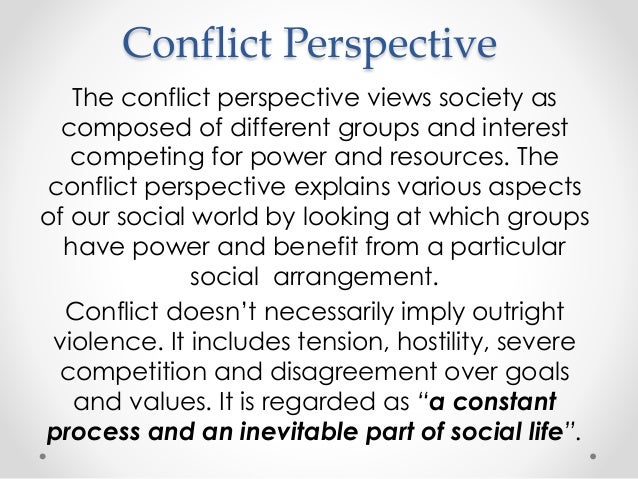
SYMBOLIC INTERACTIONISM
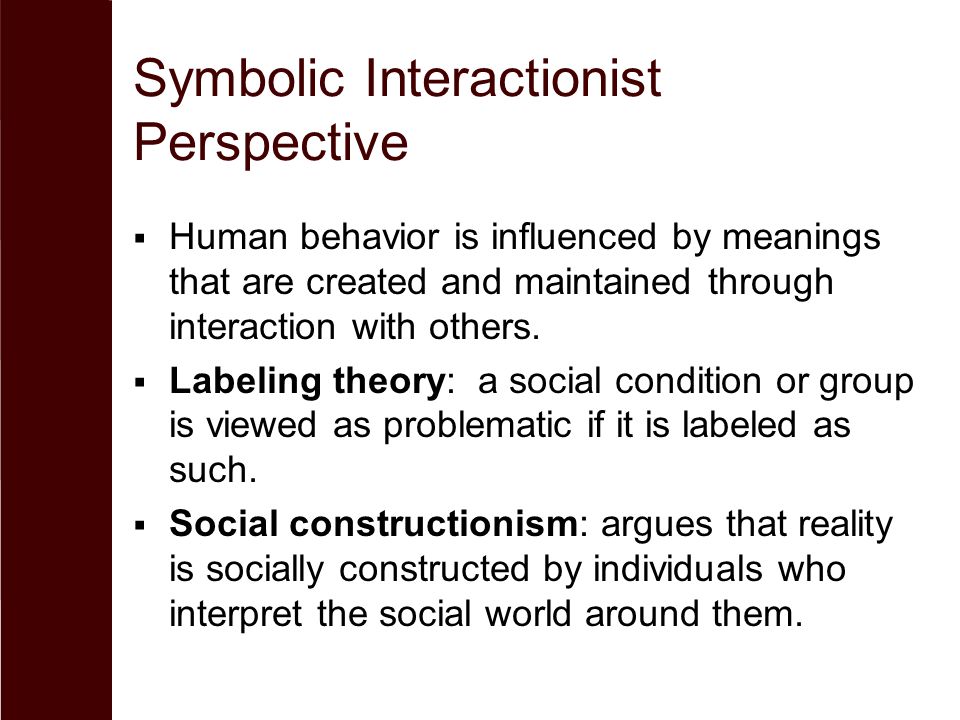
The symbolic interactionist perspective views social meaning as arising through the process of social interaction. Contemporary symbolic interactionism rests on three basic premises:
- Human beings act toward things on the basis of the meanings that they attach to Them.
- These meanings are derived from, or arise out of, social interaction with others.
- These meanings may be changed or modified through the processes of interaction and interpretation.
- Symbols in Everyday Life. Without symbols, our social life would be no more sophisticated than that of animals. For example, without symbols we would have no aunts or uncles, employers or teachers—or even brothers and sisters. This sounds strange, but it is symbols that define our relationships. There would still be reproduction, of course, but no symbols to tell us how we are related to whom. We would not know to whom we owe respect and obligations, or from whom we can expect privileges—the essence of human relationships.
- Look at it like this: If you think of someone as your aunt or uncle, you behave one way, but if you think of that person as a boyfriend or girlfriend, you behave quite differently. It is the symbol that tells you how you are related to others—and how you should act toward them.
- Let’s make this a little less abstract. Consider this example:
Suppose that you have fallen head over heels in love. Finally, after what seems forever, it is the night before your wedding. As you are contemplating tomorrow’s bliss, your mother comes to you in tears. Sobbing, she tells you that she had a child before she married your father, a child that she gave up for adoption. Breaking down, she says that she has just discovered that the person you are going to marry is this child.
You can see how the symbol will change overnight—and your behavior, too! It is not only relationships that depend on symbols to exist, but even society itself. Without symbols, we could not coordinate our actions with those of others. We could not make plans for a future day, time, and place. Unable to specify times, materials, sizes, or goals, we could not build bridges and highways. Without symbols, there would be no movies or musical instruments. We would have no hospitals, no government, no religion.
- Proponents of this perspective, often referred to as the interactionist perspective, engage in microlevel analysis, which focuses on the day-to-day interactions of individuals and groups in specific social situations. Three major concepts important for understanding this theoretical approach include meaningful symbols, the definition of the situation, and the looking-glass self. In addition, two important types of theoretical analysis fit within the interactionist perspective: dramaturgical analysis and the labelling approach.

- Meaningful Symbols: George H. Mead (1863–1931) insisted that the ongoing process of social interaction and the creating, defining, and redefining of meaningful symbols make society possible. Meaningful symbols are sounds, objects, colors, and events that represent something other than themselves and are critical for understanding social interaction. Language is one of the most important and powerful meaningful symbols humans have created, because it allows us to communicate through the shared meaning of words.
- Definition of the Situation: Definition of the situation refers to the idea that “if [people] define situations as real, they are real in their consequences” (Thomas and Thomas, 1928:572). Simply put, people define social reality through a process of give and- take interaction. Once a definition is established, it shapes all further interactions. For example, have you ever decided that you were “in love” with someone? If so, how did that change the way you interacted with that person? Conversely, what happens when a married couple decides they are no longer in love? If they define their marriage as meaningless or decide they have irreconcilable differences, how does that affect their relationship? Is a marriage likely to survive if both partners have defined it as “over”?
- The Looking-Glass Self : The looking-glass self refers to the idea that an individual’s self-concept is largely a reflection of how he or she is perceived by other members of society (Cooley, [1902] 1922). Society is used as a mirror to reflect a feeling of selfpride, self-doubt, self-worth, or self-loathing. These important elements of symbolic interactionism contribute to socialization and the process of becoming human as we establish our personal and social identities.
- Dramaturgical Analysis: A useful theoretical framework within symbolic interactionism, dramaturgical analysis, uses the analogy of the theatre to analyze social behavior. In this approach, people are viewed as actors occupying roles as they play out life’s drama. In real life, people do not passively accept others’ definitions of the situation nor the social identities assigned to them. Rather, they take an active part in the drama, manipulating the interaction to present themselves in the most positive light. Thus, people often use impression management to communicate favorable impressions of themselves (Goffman, 1959).
- The Labeling Approach: Another theoretical viewpoint within symbolic interactionism is the labeling approach, which contends that people attach various labels to certain behaviors, individuals, and groups that become part of their social identity and shape others’ attitudes about and responses to them. For example, in Outsiders, Howard Becker (1963) explored the fascinating world of jazz musicians and how their non-traditional music, penchant for marijuana, and open racial integration during the 1950s led mainstream Americans to label them “deviant.” The influence of the Chicago School and symbolic interactionism waned in the late 1950s, when a faction of sociologists argued that its approach was too dependent on ethnographic studies, personal observations, interviews, and subjective interpretations. Insisting that sociology must be more scientific, or at least, as Comte had envisioned, more positivistic, this group believed that sociology should rely more heavily on quantifiable data, facts, figures, and statistics. This led to the development of the Iowa School of symbolic interaction and also fueled a revival of structural functionalism.
Critique:
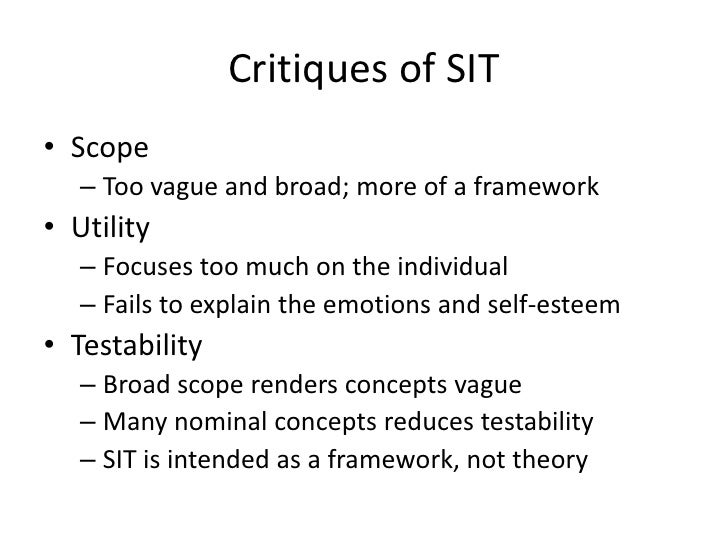
- Interactionists have often been accused of examining human interaction in a vacuum. They have tended to focus on small-scale face to face interaction with little concern for its historical or social settings (Marxian Criticism).
- They have concentrated on particular situations and encounters with little reference to the historical events which led up to them or the wider social framework in which they occur. Since these factors influence the particular interaction situation, the scant attention they have received has been regarded as a serious omission.
- While symbolic interactionism provides a corrective to the excesses of societal determinism, many critics have argued that it has gone too far in this direction. Though they claim that action is not determined by structural norms, interactionists do admit the presence of such norms. However, they tend to take them as given rather than explaining their origin.
- As William Skidmore comments, the interactionists largely fail to explain ‘why people consistently choose to act in given ways in certain situations, instead of in all the other ways they might possibly have acted’. In stressing the flexibility and freedom of human action the interactionists tend to downplay the constraints on action. In Skidmore’s view this is due to the fact that ‘interactionism consistently fails to give an account of social structure’. In other words it fails to adequately explain how standardized normative behaviour comes about and why members of society are motivated to act in terms of social norms.
- Similar criticism has been made with reference to what many see as the failure of interactionists to explain the source of the meanings to which they attach such importance. Critics argue that such meanings are not spontaneously created in interaction situations. Instead they are systematically generated by the social structure.
- Marxists have argued that the meanings which operate in face to face interaction situations are largely the product of class relationships. From this viewpoint, interactionists have failed to explain the most significant thing about meanings: the source of their origin.
- Interactionism is a distinctly American branch of sociology and to some this partly explains its shortcomings. Thus Leon Shaskolsky has argued that interactionism is largely a reflection of the cultural ideals of American society. He claims that ‘ interactionism has its roots deeply imbedded in the cultural environment of American life, and its interpretation of society is, in a sense, a “looking glass” image of what that society purports to be’. Thus the emphasis on liberty, freedom and individuality in interactionism can be seen in part as a reflection of America’s view of itself.
Phenomenology
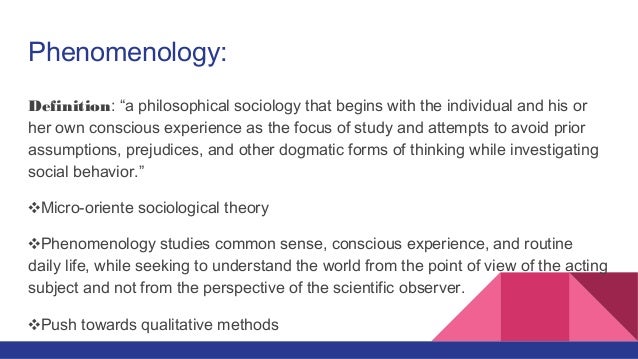
Phenomenological perspectives in sociology argue that the subject matter of the social and natural sciences is fundamentally different. As a result the methods and assumptions of the natural sciences are inappropriate to the study of man.
The natural sciences deal with matter. To understand and explain the behaviour of matter it is sufficient to observe it from the outside. Atoms and molecules do not have consciousness. They do not have meanings and purposes which direct their behaviour. Matter simply reacts ‘unconsciously’ to external stimuli; in scientific language it behaves. As a result the natural scientist is able to observe, measure, and impose an external logic on that behaviour in order to explain it. He has no need to explore the internal logic of the consciousness of matter simply because it does not exist.
- Unlike matter, man has consciousness-thoughts, feelings, meanings, intentions and an awareness of being. Because of this, his actions are meaningful; he defines situations and gives meaning to his actions and those of others. As a result, he does not merely react to external stimuli, he does not simply behave, he acts. For Example, imagine the response of early man to fire caused by volcanoes or spontaneous combustion. He did not simply react in a uniform manner to the experience of heat. He attached a range of meanings to it and these meanings directed his actions. For example he defined fire as a means of warmth and used it to heat his dwellings; as a means of defence and used it to ward off wild animals; and as a means of transforming substances and employed it for cooking and hardening the points of wooden spears. Man does not just react to fire; he acts upon it in terms of the meanings he gives to it.
- If action stems from subjective meanings, it follows that the sociologist must discover those meanings in order to understand action. He cannot simply observe action from the outside and impose an external logic upon it. He must interpret the internal logic which directs the actions of the actor.
- Max Weber was one of the first sociologists to outline this perspective in detail. He argued that sociological explanations of action should begin with ‘the observation and theoretical interpretation of the subjective “states of minds” of actors’.
Analysis
As the previous section indicated, interactionism adopts a similar approach with particular emphasis on the process of interaction. While positivists emphasize facts and cause and effect relationships, interactionists emphasize insight and understanding. Since it is not possible to get inside the heads of actors, the discovery of meaning must be based on interpretation and intuition. For this reason objective measurement is not possible and the exactitude of the natural sciences cannot be duplicated. Since meanings are constantly negotiated in ongoing interaction processes it is not possible to establish simple cause and effect relationships. Thus some sociologist argues that sociology is limited to an interpretation of social action and phenomenological approaches are sometimes referred to as ‘interpretive sociology’.
A number of sociologists have argued that the positivist approach has produced a distorted picture of social life. They see it as tending to portray man as a passive responder to external stimuli rather than an active creator of his own society. Man is pictured as reacting to various forces and pressures to economic infrastructures and the requirements of social systems.
Peter Berger argues that society has often been viewed as a puppet theatre with its members portrayed as ‘little puppets jumping about on the ends of their invisible strings, cheerfully acting out the parts that have been assigned to them’. Society instills values, norms and roles, and men dutifully respond like puppets on a string. However, from a phenomenological perspective man does not merely react and respond to an external society, he is not simply acted upon, he acts. In his interaction with others he creates his own meanings and constructs his own reality and therefore directs his own actions.
Ethnomethodology
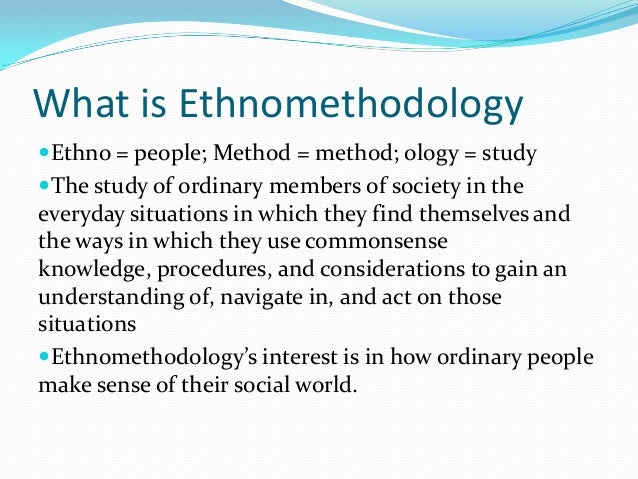
Roughly translated, ethnomethodology means the study of the methods used by people. It is concerned with examining the methods and procedures employed by members of society to construct, account for and give meaning to their social world.
Ethnomethodologists draw heavily on the European tradition of phenomenological philosophy and in particular acknowledge a debt to the ideas of the philosopher-sociologist Alfred Schutz.
Many Ethnomethodologists begin with the assumption that society exists only in so far as members perceive its existence. With this emphasis on member’s views of social reality, ethnomethodology is generally regarded as a phenomenological approach. Ethnomethodology is a developing perspective which contains a diversity of viewpoints.
One of the major concerns of sociology is the explanation of social order. From the results of numerous investigations it appears that social life is ordered and regular and that social action is systematic and patterned. Typically the sociologist has assumed that social order has an objective reality. Ethnomethodologists either suspend or abandon the belief that an actual or objective social order exists. Instead they proceed from the assumption that social life appears orderly to members of society.
Thus in the eyes of members their everyday activities seem ordered and systematic but this order is not necessarily due to the intrinsic nature or inherent qualities of the social world. In other words it may not actually exist. Rather it may simply appear to exist because of the way members perceive and interpret social reality. Social order therefore becomes a convenient fiction, an appearance of order constructed by members of society. This appearance allows the social world to be described and explained and so made knowable, reasonable, understandable and ‘accountable’ to its members.
The methods and accounting procedures used by members for creating a sense of order form the subject matter of ethnomethodological enquiry. Zimmerman and Wieder state that the ethnomethodologist is ‘concerned with how members of society go about the task of seeing, describing and explaining order in the world in which they live’.
Ethnomethodologists are highly critical of other branches of sociology. They argue that ‘conventional’ sociologists have misunderstood the nature of social reality. They have treated the social world as if it had an objective reality which is independent of members’ accounts and interpretations. Thus they have regarded aspects of the social world such as suicide and crime as facts with an existence of their own. They have then attempted to provide explanations for these ‘facts’. By contrast, ethnomethodologist argues that the social world consists of nothing more than the constructs, interpretations and accounts of its members. The job of the sociologist is therefore to explain the methods and accounting procedures which members employ to construct their social world. According to Ethnomethodologists, this is the very job that mainstream sociology has failed to do.
Ethnomethodologist sees little difference between conventional sociologists and the man in the street. They argue that the methods employed by sociologists in their research are basically similar to those used by members of society in their everyday lives. Members employing the documentary method are constantly theorizing, drawing relationships between activities and making the social world appear orderly and systematic. They then treat the social world as if it had an objective reality separate from themselves. Ethnomethodologists argue that the procedures of conventional sociologists are essentially similar. They employ the documentary method, theorize and draw relationships and construct a picture of an orderly and systematic social system. They operate reflexively like any other member of society. Thus when a functionalist sees behaviour as an expression of an underlying pattern of shared values, he also used instances of that behaviour as evidence for the existence of the pattern. By means of their accounting procedures members construct a picture of society. In this sense the man in the street is his own sociologist. Ethnomethodologists see little to choose between the pictures of society which he creates and those provided by conventional sociologists.
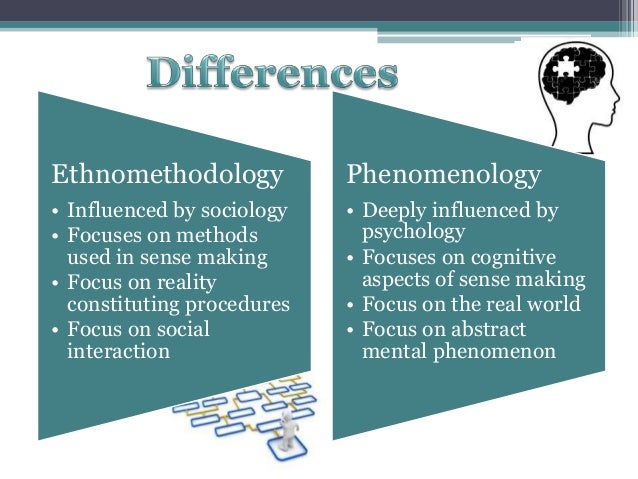
Critique to Ethnomethodology :
Ethnomethodology has labeled as conventional or ‘folk’ sociology. Its critics have argued that the members who populate the kind of society portrayed by Ethnomethodologists appear to lack any motives and goals.
As Anthony Giddens remarks, there is little reference to ‘the pursuance of practical goals or interests’. There is little indication in the writings of Ethnomethodologists as to why people want to behave or are made to behave in particular ways. Nor is there much consideration of the nature of power in the social world and the possible effects of differences in power on members behaviour.
As Gouldner notes, ‘The process by which social reality becomes defined and established is not viewed by Garfinkel as entailing a process of struggle among competing groups’ definitions of reality, and the outcome, the common sense conception of the world, is not seen as having been shaped by institutionally protected power differences’.
Critics have argued that Ethnomethodologists have failed to give due consideration to the fact that members’ accounting procedures are conducted within a system of social relationships involving differences in power. Many Ethnomethodo-logists appear to dismiss everything which is not recognized and accounted for by members of society. They imply that if members do not recognize the existence of objects and events, they are unaffected by them. But as John H. Goldthorpe pointedly remarks in his criticism of ethnomethodology, ‘If for instance, it is bombs and napalm that are zooming down, members do not have to be oriented towards them in any particular way, or at all, in order to be killed by them’. Clearly members do not have to recognize certain constraints in order for their behaviour to be affected by them. As Goldthorpe notes, with reference to the above example, death ‘limits interaction in a fairly decisive way’. Finally, the Ethnomethodologists’ criticism of mainstream sociology can be redirected to themselves.
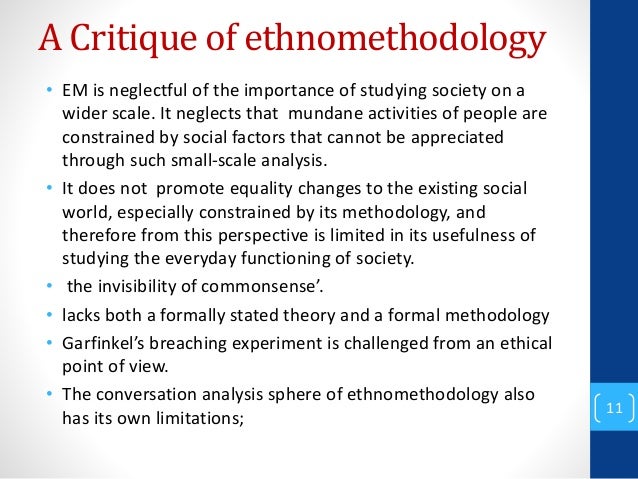
As Giddens remarks, ‘any ethnomethodo-logical account must display the same characteristics as it claims to discern in the accounts of lay actors’. Ethnomethodologists’ accounting procedures therefore become a topic for study like those of conventional sociologists or any other member of society. In theory the process of accounting for accounts is never ending. Carried to its extreme, the ethnomethodological position implies that nothing is every knowable.
For more such notes, Articles, News & Views Join our Telegram Channel.
Click the link below to see the details about the UPSC –Civils courses offered by Triumph IAS. https://triumphias.com/pages-all-courses.php

